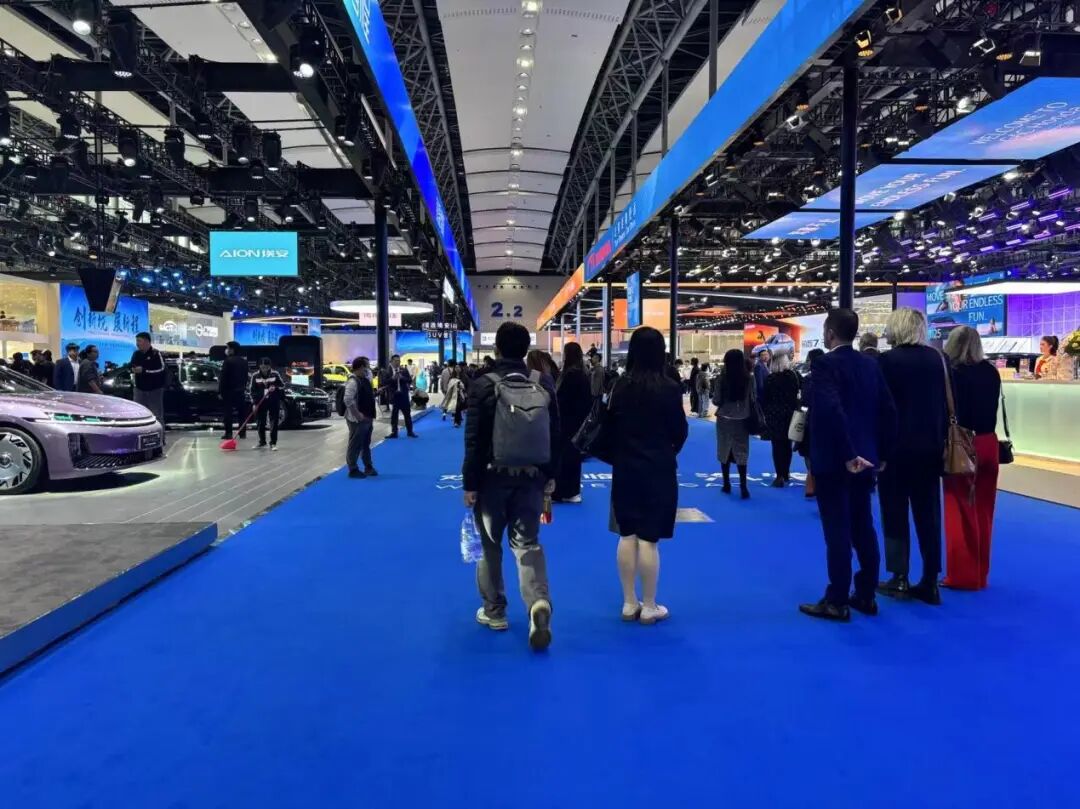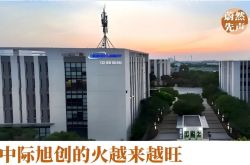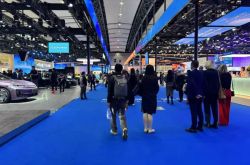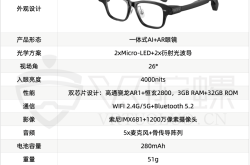Why Can GAC Toyota Break Through the Impasse?
![]() 11/28 2025
11/28 2025
![]() 350
350
Introduction | Lead
By delving into the array of actions and strategies GAC Toyota has employed for its new product launches at the Guangzhou Auto Show, we gain a clear understanding of the arduous battle joint-venture automakers face as they step into the 'post-joint-venture era' amidst severe challenges. This situation also heralds a new trend emerging from the rise of leading automakers, namely the new quality productive forces characterized by 'winning through strategy and triumphing through culture.' Such forces transcend the chaos of disorderly competition, propel the industry towards proactive development, and set an upward pace.
Published by | Heyan Yueche Studio
Written by | Yan Guangming
Edited by | He Zi
Full text: 2031 words
Reading time: 4 minutes
What stands out as the biggest highlight of this year's Guangzhou Auto Show? Is it the advancements in product technology or the persuasiveness of marketing rhetoric? Neither seems to be the case. Instead, the focus lies in discerning market trends and industry directions to uncover new sensations.

In the automotive landscape, marked by product homogenization, technological resemblance, excessive marketing, and a virtualized future, all stakeholders—be it the industry, manufacturers, the market, or, most importantly, the users as the consuming main body—find themselves inadvertently ensnared in a collective state of confusion and perplexity regarding automotive cognition. This scenario can be vividly encapsulated as: 'The industry lacks a guiding spirit, enterprises lack direction, and the market lacks cultural depth.'
Some may challenge this perspective, dismissing it as a disregard for facts. However, a calm and objective observation of the current state of the entire industry would suggest otherwise. Why?
Self-owned brands are thriving, with new vehicle launches being celebrated as if they were a batch of boiling dumplings. On the other hand, some joint-venture automakers are tightening production, closing factories, laying off staff, losing morale, and fading into obscurity. Certain foreign brands are teetering on the brink, with various speculations and rumors frequently making it to the top searches, being hyped up and discussed. Some new forces are over-marketing, turning the industry into a disaster zone, affecting society, alarming higher authorities, and prompting statements from central media.
Given all these circumstances, who can remain unconcerned? Yet, the reality is that public opinion is either silent or complacent, with uncontrolled dissemination where truth and falsehood are indistinguishable. Numerous incidents indicate that in today's automotive industry, there is no such thing as unbiased news, only marketing. The truth and reality are elusive, like viewing flowers through fog—unclear and indescribable. Over the past forty-plus years since reform and opening up, Chinese automotive development has experienced ups and downs, endured hardships, and persevered, finally changing its fate. However, with its current rise to prominence, why are there still so many disharmonies and anxieties? This cannot be ignored.
'The more new cars, the greater the worries; the more advanced automotive technology, the more profound and unfathomable it becomes.' From the happiness of 'contentment with small prosperity' to the current state of 'affluent poverty,' in reality, automobiles bring us not just changes but also questions on how to master them, along with numerous problems and thorny issues...
At the auto show, what one observes is a phenomenon of scrambling for limited opportunities or a relentless pile-up of product features or escalations, coupled with price wars in 'text regeneration.' Rarely do we witness breakthroughs, changes in consciousness, or consumer progress that can stand atop the era's mast as a 'beacon.' Against this backdrop, GAC Toyota's proposal of the 'Strong in Both Fuel and Electric Vehicles' strategy shines brightly, representing a mindset that breaks free from the conventional, finding the 'key' for joint ventures to move towards integration, fusion, and co-creation. It opens a sustainable progression path from the balance of 'China defining global vehicles,' relying on the system, adhering to 'userism,' and making it possible to build a trusted brand that stands out.

From reshaping the new image of fuel vehicles (hybrid) with the all-new Wildlander (intelligent vehicle) to launching the bZ4X pure electric D-segment luxury sedan at a pre-sale price in the 200,000 yuan range, GAC Toyota has garnered widespread attention both within and outside the industry. With this, GAC Toyota conveys to users in the most emotional and tangible way the entire process of automotive revolution from fuel vehicles to hybrids, then to electric and intelligent vehicles. It emphasizes that only by mastering systematic technology, understanding automotive philosophy, and possessing humanistic concepts can one provide users with a value experience that is reassuring to buy, practical to use, and fulfilling. The manufacturer points out that these two models are not mere additions to the product lineup but two entirely new 'categories,' which can be seen as a microcosm of current industry development. I believe that 'Strong in Both Fuel and Electric Vehicles' is not a distant slogan but an ongoing industrial reality, a 'preview' of industry innovation.
It seems that this is the biggest highlight of this year's Guangzhou Auto Show, not about products and technology, nor about driving traffic and marketing, but about promoting a vision and mindset of 'universal value,' 'mass-producing happiness,' and 'equal welfare.' Simply put, this is the difference between humanistic automotive manufacturing and capital-driven automotive manufacturing. It provides automobiles with a way to break free from the conventional, strive for greater space, and release boundless energy, not just limited to material competition but encompassing endless humanistic needs.
In fact, the all-new Wildlander and bZ4X are not new revelations. They were already teased at this year's Import Expo held in Shanghai, becoming part of Toyota's strategy to 'establish globally, more so in China,' winning recognition from many experts and higher authorities (automotive transformation and development should be driven by multiple factors). This move tells us: without the guidance of humanistic culture, automotive technology would be like a wild horse without a rein, unsure of which direction to go.

Therefore, GAC Toyota's calm display and expression at the Guangzhou Auto Show precisely serve as a beam of light piercing through the fog to alleviate 'automotive anxiety.' Nowadays, many automakers mention 'Strong in Both Fuel and Electric Vehicles,' but few can present hardcore products in both fuel and electric sectors that are market-recognized. While hesitating between 'going all-in on electrification' and 'clinging to fuel vehicles,' GAC Toyota has proven with its hardcore products and technology, market performance, and consumer reputation that 'advancing on both fuel and electric fronts, and being strong in both' is not impossible.
This year marks GAC Toyota's 'year of transformation,' next year will be a year of exertion, with production and sales exceeding 800,000 units, and the following year aiming for a 10% growth, laying a solid foundation for returning to a million units in production and sales by 2028. It's evident that this is a systematic reform and deep transformation, concerning not just products and technology but also a comprehensive restructuring of user services, channel innovations, etc. The key lies in elevating 'extreme userism' to the cognition of 'automotive humanism,' providing an adapted solution to alleviate current automotive field anxiety. It truly transforms 'long-termism' into an effective output of 'trust culture.'
By delving into the array of actions and strategies GAC Toyota has employed for its new product launches at the Guangzhou Auto Show, we gain a clear understanding of the arduous battle joint-venture automakers face as they step into the 'post-joint-venture era' amidst severe challenges. This situation also heralds a new trend emerging from the rise of leading automakers, namely the new quality productive forces characterized by 'winning through strategy and triumphing through culture.' Such forces transcend the chaos of disorderly competition, propel the industry towards proactive development, and set an upward pace.
Commentary
This is a systematic reform and deep transformation, concerning not just products and technology but also a comprehensive restructuring of user services, channel innovations, etc. The key lies in elevating 'extreme userism' to the cognition of 'automotive humanism,' providing an adapted solution to alleviate current automotive field anxiety. It truly transforms 'long-termism' into an effective output of 'trust culture.'
(This article is original to 'Heyan Yueche' and may not be reproduced without authorization.)








